MBA 550: Leadership Analysis of Steve Jobs, Apple's Vision and Culture
VerifiedAdded on 2022/11/14
|8
|1323
|79
Report
AI Summary
This report provides an in-depth analysis of Steve Jobs' leadership style, organizational vision, and its impact on Apple's strategic direction and company culture. The report begins with an executive summary and table of contents, followed by an introduction outlining the objectives. It identifies Jobs' organizational vision, which centered around being different, and examines how he developed Apple's strategic direction. The analysis further explores methods that Jobs could have used, such as avoiding constant challenges and refraining from distorting reality. The report then presents evidence of how Jobs' personal, political, and positional power defined Apple's structure and culture, specifically focusing on design, business model revival, and a commitment to doing things differently. The conclusion emphasizes the importance of leadership in shaping workplace culture and driving organizational success, referencing key sources to support the findings.
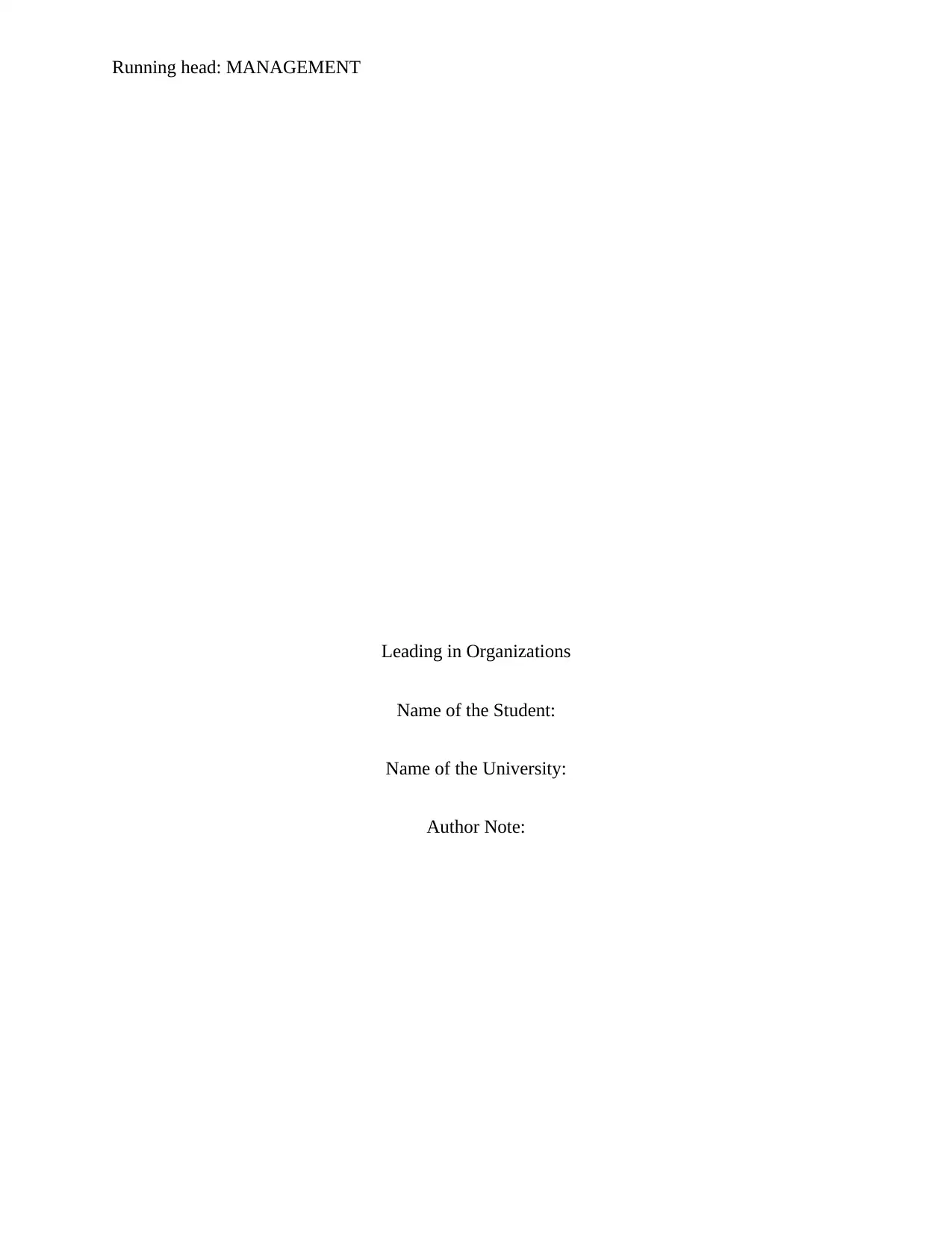
Running head: MANAGEMENT
Leading in Organizations
Name of the Student:
Name of the University:
Author Note:
Leading in Organizations
Name of the Student:
Name of the University:
Author Note:
Paraphrase This Document
Need a fresh take? Get an instant paraphrase of this document with our AI Paraphraser
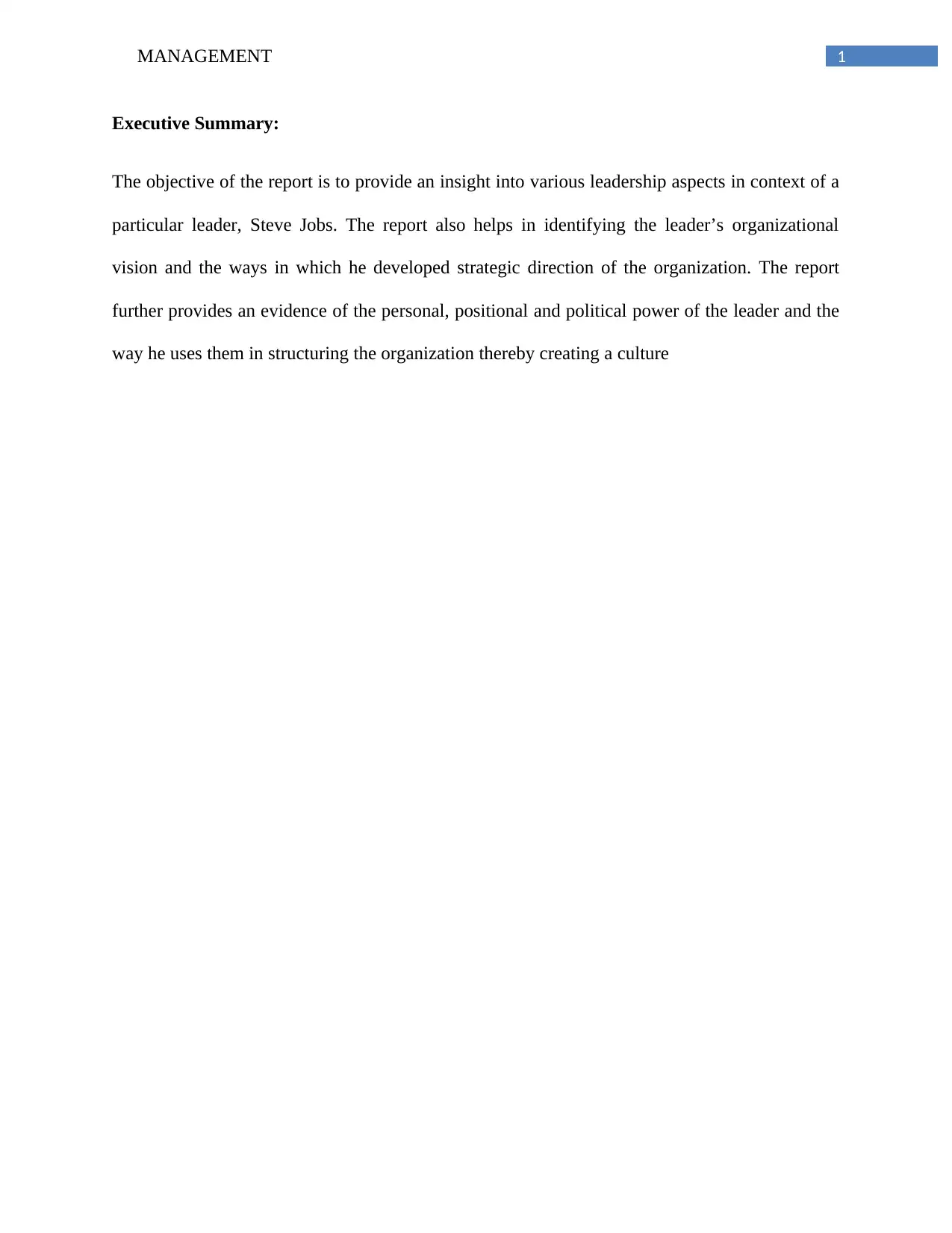
1MANAGEMENT
Executive Summary:
The objective of the report is to provide an insight into various leadership aspects in context of a
particular leader, Steve Jobs. The report also helps in identifying the leader’s organizational
vision and the ways in which he developed strategic direction of the organization. The report
further provides an evidence of the personal, positional and political power of the leader and the
way he uses them in structuring the organization thereby creating a culture
Executive Summary:
The objective of the report is to provide an insight into various leadership aspects in context of a
particular leader, Steve Jobs. The report also helps in identifying the leader’s organizational
vision and the ways in which he developed strategic direction of the organization. The report
further provides an evidence of the personal, positional and political power of the leader and the
way he uses them in structuring the organization thereby creating a culture
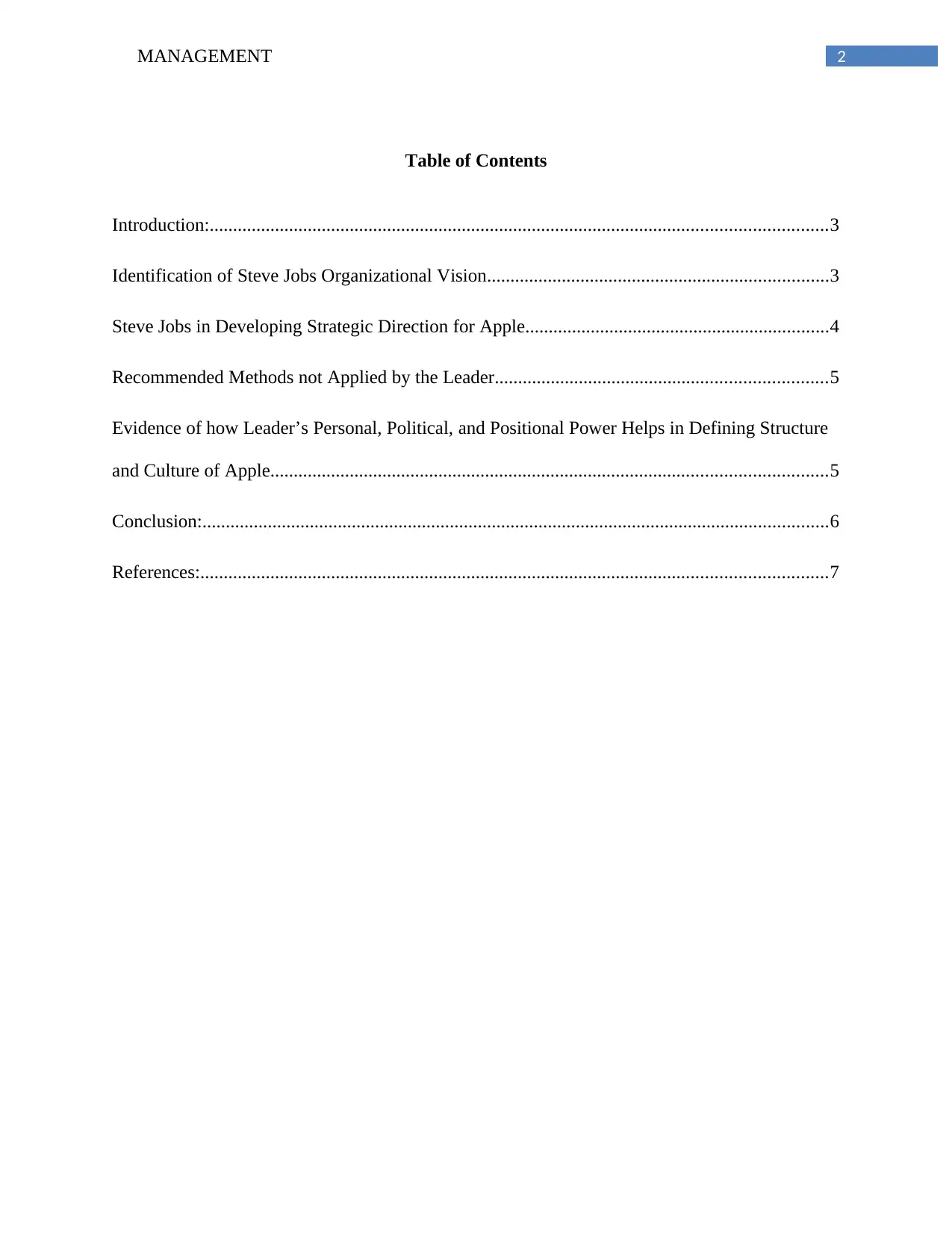
2MANAGEMENT
Table of Contents
Introduction:....................................................................................................................................3
Identification of Steve Jobs Organizational Vision.........................................................................3
Steve Jobs in Developing Strategic Direction for Apple.................................................................4
Recommended Methods not Applied by the Leader.......................................................................5
Evidence of how Leader’s Personal, Political, and Positional Power Helps in Defining Structure
and Culture of Apple.......................................................................................................................5
Conclusion:......................................................................................................................................6
References:......................................................................................................................................7
Table of Contents
Introduction:....................................................................................................................................3
Identification of Steve Jobs Organizational Vision.........................................................................3
Steve Jobs in Developing Strategic Direction for Apple.................................................................4
Recommended Methods not Applied by the Leader.......................................................................5
Evidence of how Leader’s Personal, Political, and Positional Power Helps in Defining Structure
and Culture of Apple.......................................................................................................................5
Conclusion:......................................................................................................................................6
References:......................................................................................................................................7
⊘ This is a preview!⊘
Do you want full access?
Subscribe today to unlock all pages.

Trusted by 1+ million students worldwide
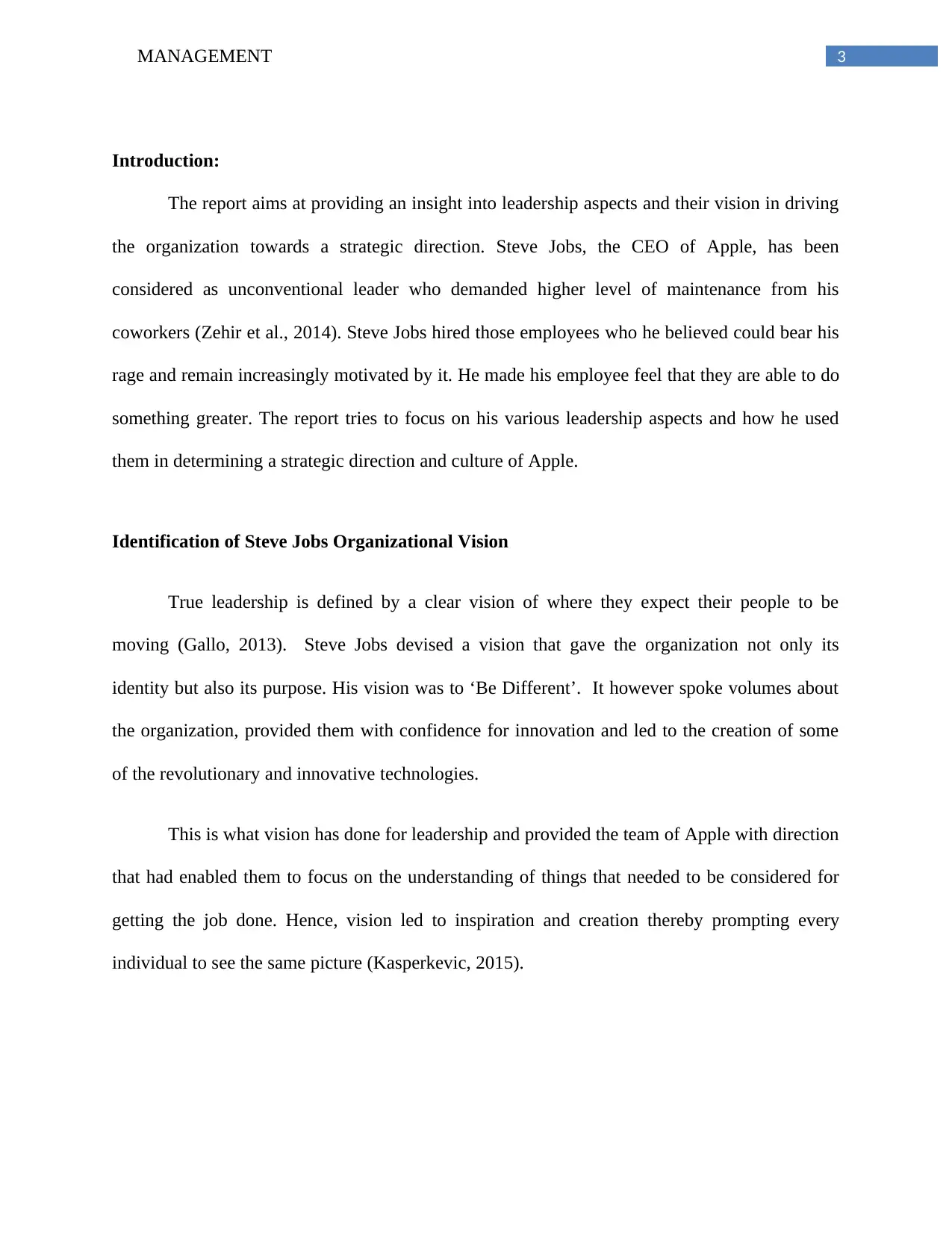
3MANAGEMENT
Introduction:
The report aims at providing an insight into leadership aspects and their vision in driving
the organization towards a strategic direction. Steve Jobs, the CEO of Apple, has been
considered as unconventional leader who demanded higher level of maintenance from his
coworkers (Zehir et al., 2014). Steve Jobs hired those employees who he believed could bear his
rage and remain increasingly motivated by it. He made his employee feel that they are able to do
something greater. The report tries to focus on his various leadership aspects and how he used
them in determining a strategic direction and culture of Apple.
Identification of Steve Jobs Organizational Vision
True leadership is defined by a clear vision of where they expect their people to be
moving (Gallo, 2013). Steve Jobs devised a vision that gave the organization not only its
identity but also its purpose. His vision was to ‘Be Different’. It however spoke volumes about
the organization, provided them with confidence for innovation and led to the creation of some
of the revolutionary and innovative technologies.
This is what vision has done for leadership and provided the team of Apple with direction
that had enabled them to focus on the understanding of things that needed to be considered for
getting the job done. Hence, vision led to inspiration and creation thereby prompting every
individual to see the same picture (Kasperkevic, 2015).
Introduction:
The report aims at providing an insight into leadership aspects and their vision in driving
the organization towards a strategic direction. Steve Jobs, the CEO of Apple, has been
considered as unconventional leader who demanded higher level of maintenance from his
coworkers (Zehir et al., 2014). Steve Jobs hired those employees who he believed could bear his
rage and remain increasingly motivated by it. He made his employee feel that they are able to do
something greater. The report tries to focus on his various leadership aspects and how he used
them in determining a strategic direction and culture of Apple.
Identification of Steve Jobs Organizational Vision
True leadership is defined by a clear vision of where they expect their people to be
moving (Gallo, 2013). Steve Jobs devised a vision that gave the organization not only its
identity but also its purpose. His vision was to ‘Be Different’. It however spoke volumes about
the organization, provided them with confidence for innovation and led to the creation of some
of the revolutionary and innovative technologies.
This is what vision has done for leadership and provided the team of Apple with direction
that had enabled them to focus on the understanding of things that needed to be considered for
getting the job done. Hence, vision led to inspiration and creation thereby prompting every
individual to see the same picture (Kasperkevic, 2015).
Paraphrase This Document
Need a fresh take? Get an instant paraphrase of this document with our AI Paraphraser
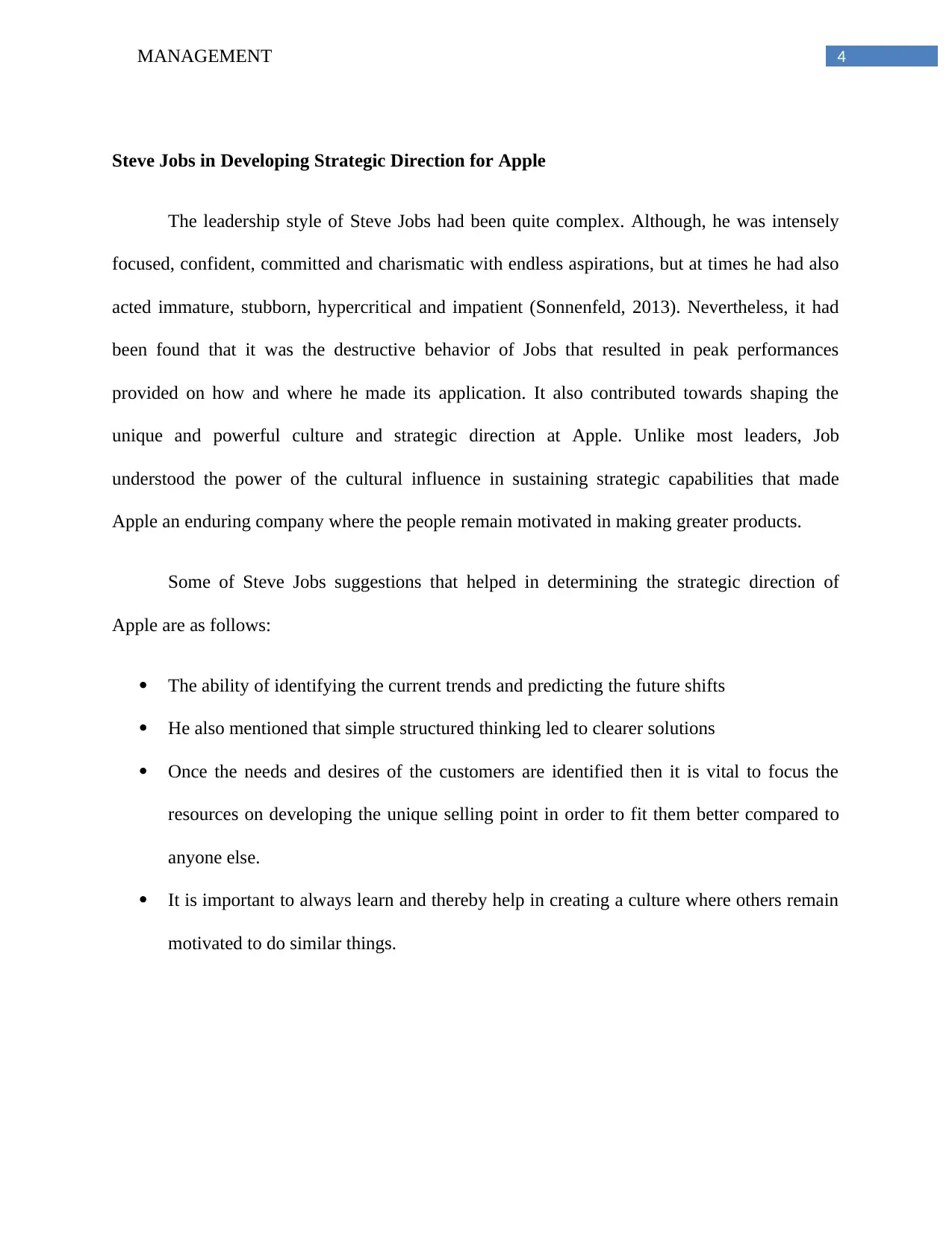
4MANAGEMENT
Steve Jobs in Developing Strategic Direction for Apple
The leadership style of Steve Jobs had been quite complex. Although, he was intensely
focused, confident, committed and charismatic with endless aspirations, but at times he had also
acted immature, stubborn, hypercritical and impatient (Sonnenfeld, 2013). Nevertheless, it had
been found that it was the destructive behavior of Jobs that resulted in peak performances
provided on how and where he made its application. It also contributed towards shaping the
unique and powerful culture and strategic direction at Apple. Unlike most leaders, Job
understood the power of the cultural influence in sustaining strategic capabilities that made
Apple an enduring company where the people remain motivated in making greater products.
Some of Steve Jobs suggestions that helped in determining the strategic direction of
Apple are as follows:
The ability of identifying the current trends and predicting the future shifts
He also mentioned that simple structured thinking led to clearer solutions
Once the needs and desires of the customers are identified then it is vital to focus the
resources on developing the unique selling point in order to fit them better compared to
anyone else.
It is important to always learn and thereby help in creating a culture where others remain
motivated to do similar things.
Steve Jobs in Developing Strategic Direction for Apple
The leadership style of Steve Jobs had been quite complex. Although, he was intensely
focused, confident, committed and charismatic with endless aspirations, but at times he had also
acted immature, stubborn, hypercritical and impatient (Sonnenfeld, 2013). Nevertheless, it had
been found that it was the destructive behavior of Jobs that resulted in peak performances
provided on how and where he made its application. It also contributed towards shaping the
unique and powerful culture and strategic direction at Apple. Unlike most leaders, Job
understood the power of the cultural influence in sustaining strategic capabilities that made
Apple an enduring company where the people remain motivated in making greater products.
Some of Steve Jobs suggestions that helped in determining the strategic direction of
Apple are as follows:
The ability of identifying the current trends and predicting the future shifts
He also mentioned that simple structured thinking led to clearer solutions
Once the needs and desires of the customers are identified then it is vital to focus the
resources on developing the unique selling point in order to fit them better compared to
anyone else.
It is important to always learn and thereby help in creating a culture where others remain
motivated to do similar things.
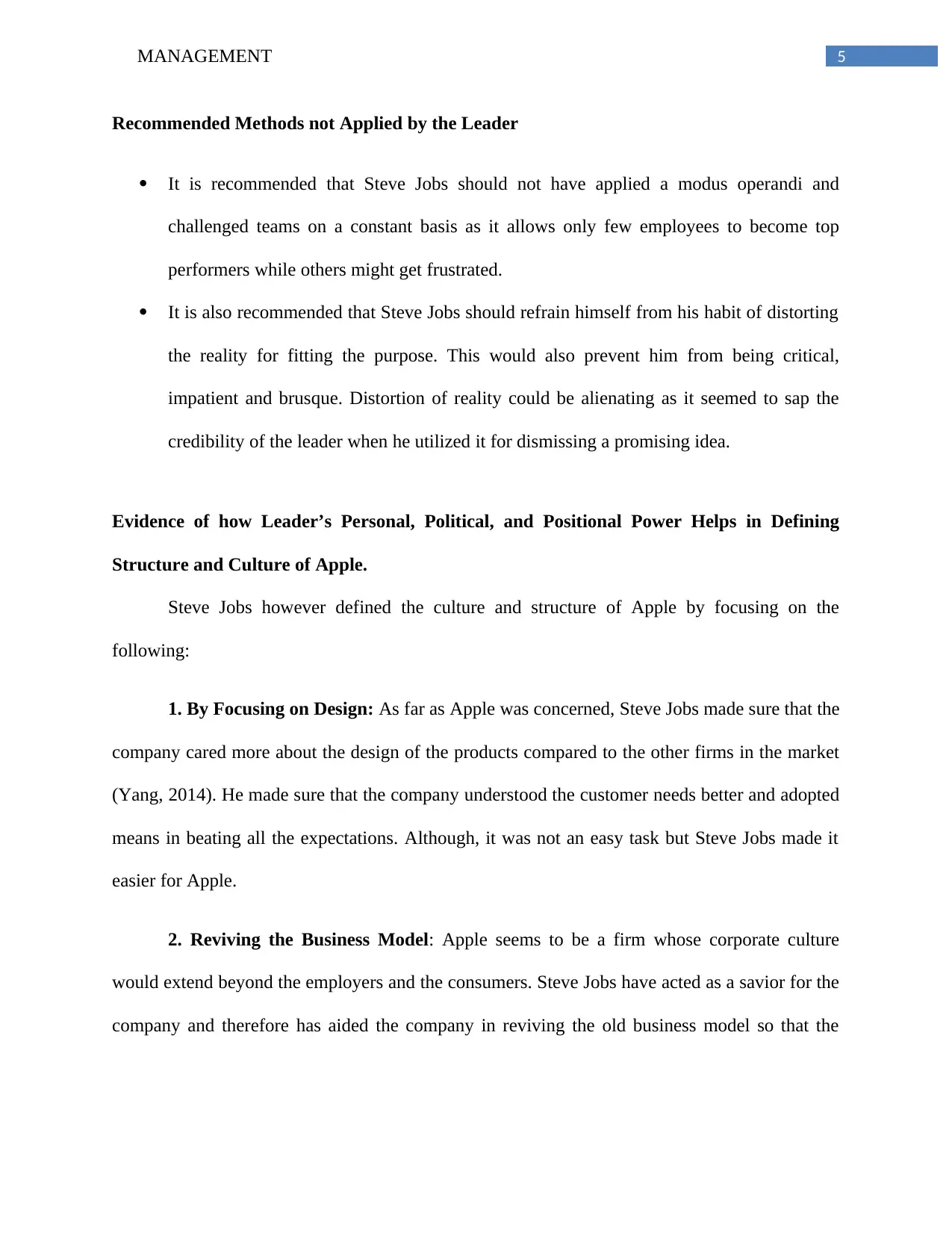
5MANAGEMENT
Recommended Methods not Applied by the Leader
It is recommended that Steve Jobs should not have applied a modus operandi and
challenged teams on a constant basis as it allows only few employees to become top
performers while others might get frustrated.
It is also recommended that Steve Jobs should refrain himself from his habit of distorting
the reality for fitting the purpose. This would also prevent him from being critical,
impatient and brusque. Distortion of reality could be alienating as it seemed to sap the
credibility of the leader when he utilized it for dismissing a promising idea.
Evidence of how Leader’s Personal, Political, and Positional Power Helps in Defining
Structure and Culture of Apple.
Steve Jobs however defined the culture and structure of Apple by focusing on the
following:
1. By Focusing on Design: As far as Apple was concerned, Steve Jobs made sure that the
company cared more about the design of the products compared to the other firms in the market
(Yang, 2014). He made sure that the company understood the customer needs better and adopted
means in beating all the expectations. Although, it was not an easy task but Steve Jobs made it
easier for Apple.
2. Reviving the Business Model: Apple seems to be a firm whose corporate culture
would extend beyond the employers and the consumers. Steve Jobs have acted as a savior for the
company and therefore has aided the company in reviving the old business model so that the
Recommended Methods not Applied by the Leader
It is recommended that Steve Jobs should not have applied a modus operandi and
challenged teams on a constant basis as it allows only few employees to become top
performers while others might get frustrated.
It is also recommended that Steve Jobs should refrain himself from his habit of distorting
the reality for fitting the purpose. This would also prevent him from being critical,
impatient and brusque. Distortion of reality could be alienating as it seemed to sap the
credibility of the leader when he utilized it for dismissing a promising idea.
Evidence of how Leader’s Personal, Political, and Positional Power Helps in Defining
Structure and Culture of Apple.
Steve Jobs however defined the culture and structure of Apple by focusing on the
following:
1. By Focusing on Design: As far as Apple was concerned, Steve Jobs made sure that the
company cared more about the design of the products compared to the other firms in the market
(Yang, 2014). He made sure that the company understood the customer needs better and adopted
means in beating all the expectations. Although, it was not an easy task but Steve Jobs made it
easier for Apple.
2. Reviving the Business Model: Apple seems to be a firm whose corporate culture
would extend beyond the employers and the consumers. Steve Jobs have acted as a savior for the
company and therefore has aided the company in reviving the old business model so that the
⊘ This is a preview!⊘
Do you want full access?
Subscribe today to unlock all pages.

Trusted by 1+ million students worldwide
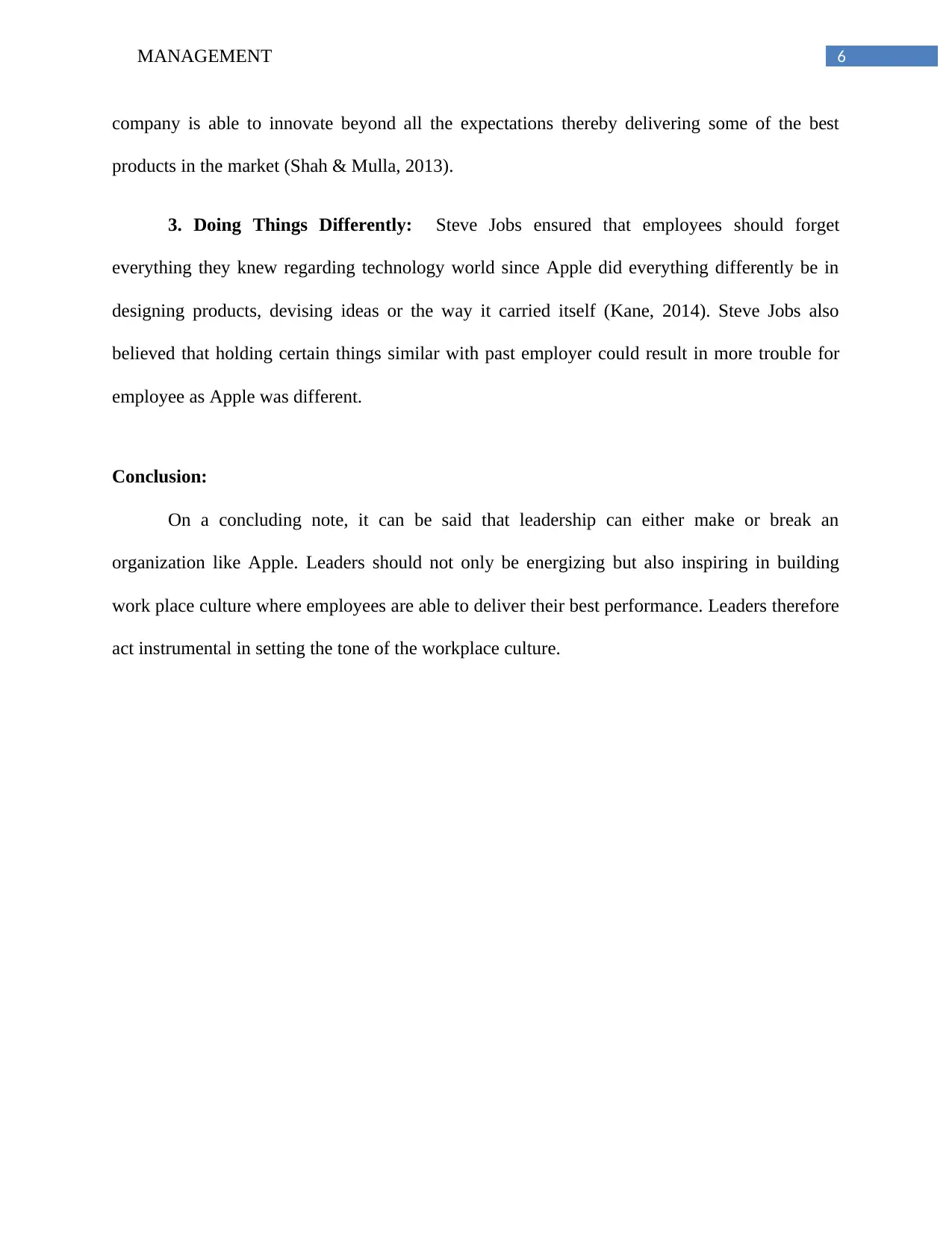
6MANAGEMENT
company is able to innovate beyond all the expectations thereby delivering some of the best
products in the market (Shah & Mulla, 2013).
3. Doing Things Differently: Steve Jobs ensured that employees should forget
everything they knew regarding technology world since Apple did everything differently be in
designing products, devising ideas or the way it carried itself (Kane, 2014). Steve Jobs also
believed that holding certain things similar with past employer could result in more trouble for
employee as Apple was different.
Conclusion:
On a concluding note, it can be said that leadership can either make or break an
organization like Apple. Leaders should not only be energizing but also inspiring in building
work place culture where employees are able to deliver their best performance. Leaders therefore
act instrumental in setting the tone of the workplace culture.
company is able to innovate beyond all the expectations thereby delivering some of the best
products in the market (Shah & Mulla, 2013).
3. Doing Things Differently: Steve Jobs ensured that employees should forget
everything they knew regarding technology world since Apple did everything differently be in
designing products, devising ideas or the way it carried itself (Kane, 2014). Steve Jobs also
believed that holding certain things similar with past employer could result in more trouble for
employee as Apple was different.
Conclusion:
On a concluding note, it can be said that leadership can either make or break an
organization like Apple. Leaders should not only be energizing but also inspiring in building
work place culture where employees are able to deliver their best performance. Leaders therefore
act instrumental in setting the tone of the workplace culture.
Paraphrase This Document
Need a fresh take? Get an instant paraphrase of this document with our AI Paraphraser
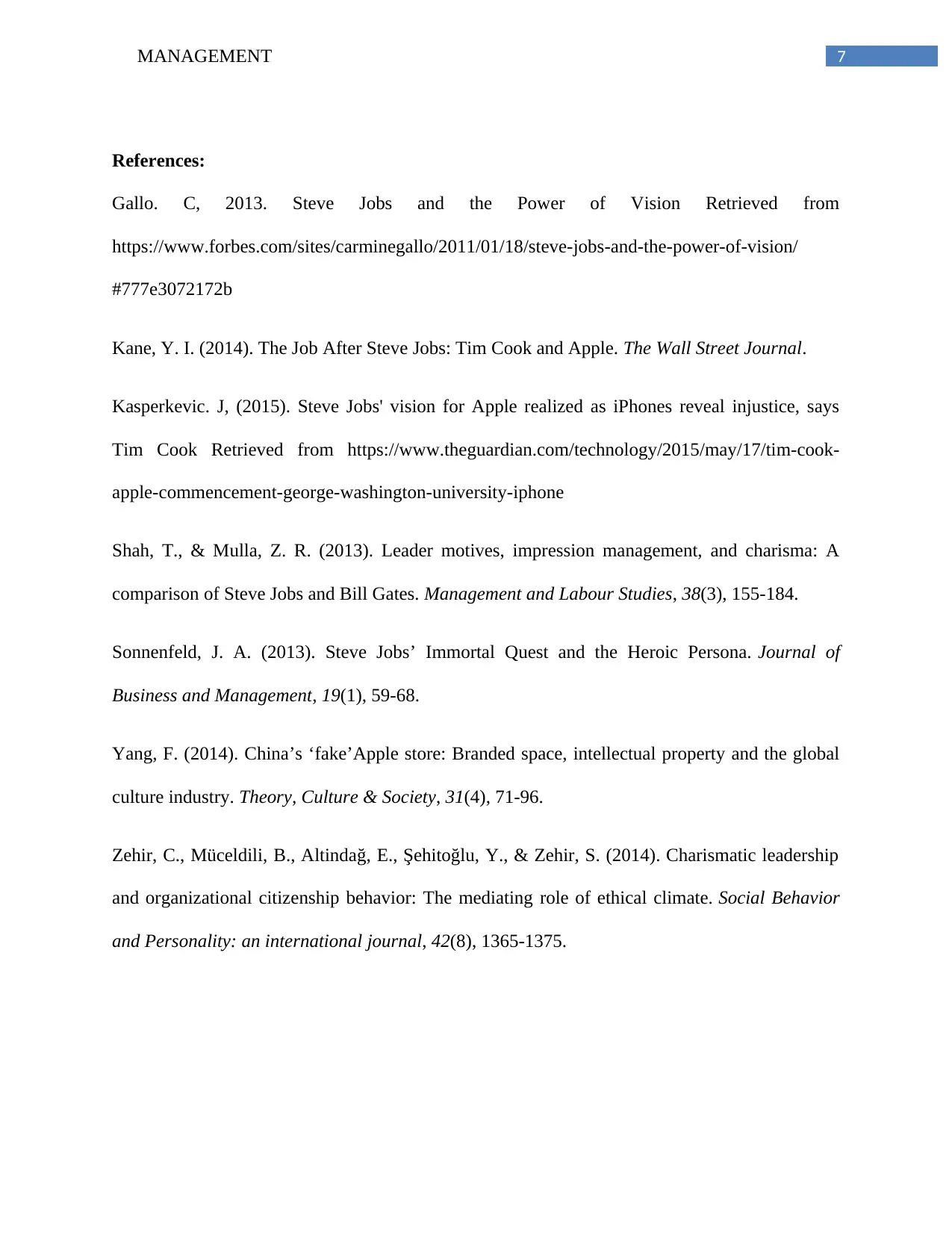
7MANAGEMENT
References:
Gallo. C, 2013. Steve Jobs and the Power of Vision Retrieved from
https://www.forbes.com/sites/carminegallo/2011/01/18/steve-jobs-and-the-power-of-vision/
#777e3072172b
Kane, Y. I. (2014). The Job After Steve Jobs: Tim Cook and Apple. The Wall Street Journal.
Kasperkevic. J, (2015). Steve Jobs' vision for Apple realized as iPhones reveal injustice, says
Tim Cook Retrieved from https://www.theguardian.com/technology/2015/may/17/tim-cook-
apple-commencement-george-washington-university-iphone
Shah, T., & Mulla, Z. R. (2013). Leader motives, impression management, and charisma: A
comparison of Steve Jobs and Bill Gates. Management and Labour Studies, 38(3), 155-184.
Sonnenfeld, J. A. (2013). Steve Jobs’ Immortal Quest and the Heroic Persona. Journal of
Business and Management, 19(1), 59-68.
Yang, F. (2014). China’s ‘fake’Apple store: Branded space, intellectual property and the global
culture industry. Theory, Culture & Society, 31(4), 71-96.
Zehir, C., Müceldili, B., Altindağ, E., Şehitoğlu, Y., & Zehir, S. (2014). Charismatic leadership
and organizational citizenship behavior: The mediating role of ethical climate. Social Behavior
and Personality: an international journal, 42(8), 1365-1375.
References:
Gallo. C, 2013. Steve Jobs and the Power of Vision Retrieved from
https://www.forbes.com/sites/carminegallo/2011/01/18/steve-jobs-and-the-power-of-vision/
#777e3072172b
Kane, Y. I. (2014). The Job After Steve Jobs: Tim Cook and Apple. The Wall Street Journal.
Kasperkevic. J, (2015). Steve Jobs' vision for Apple realized as iPhones reveal injustice, says
Tim Cook Retrieved from https://www.theguardian.com/technology/2015/may/17/tim-cook-
apple-commencement-george-washington-university-iphone
Shah, T., & Mulla, Z. R. (2013). Leader motives, impression management, and charisma: A
comparison of Steve Jobs and Bill Gates. Management and Labour Studies, 38(3), 155-184.
Sonnenfeld, J. A. (2013). Steve Jobs’ Immortal Quest and the Heroic Persona. Journal of
Business and Management, 19(1), 59-68.
Yang, F. (2014). China’s ‘fake’Apple store: Branded space, intellectual property and the global
culture industry. Theory, Culture & Society, 31(4), 71-96.
Zehir, C., Müceldili, B., Altindağ, E., Şehitoğlu, Y., & Zehir, S. (2014). Charismatic leadership
and organizational citizenship behavior: The mediating role of ethical climate. Social Behavior
and Personality: an international journal, 42(8), 1365-1375.
1 out of 8
Related Documents
Your All-in-One AI-Powered Toolkit for Academic Success.
+13062052269
info@desklib.com
Available 24*7 on WhatsApp / Email
![[object Object]](/_next/static/media/star-bottom.7253800d.svg)
Unlock your academic potential
Copyright © 2020–2025 A2Z Services. All Rights Reserved. Developed and managed by ZUCOL.




